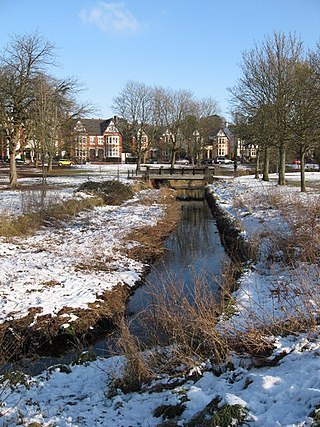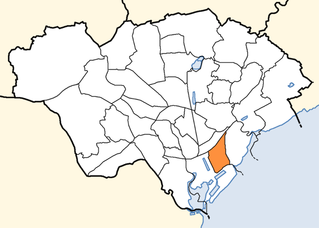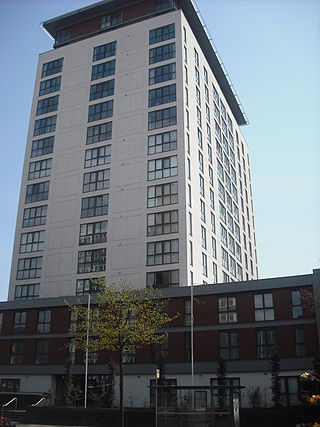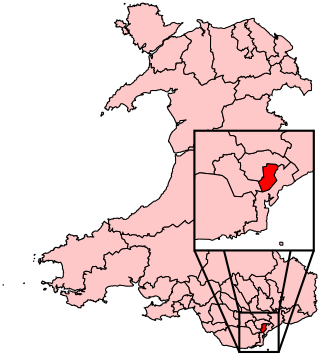
The Royal Oak is a Grade II listed public house on Newport Road in the Adamsdown/Roath area of Cardiff, Wales. [1]

The Royal Oak is a Grade II listed public house on Newport Road in the Adamsdown/Roath area of Cardiff, Wales. [1]
The pub dates from the late 19th century. In the early part of the 20th century it was run by a cousin of the boxer, Jim Driscoll, who on his death bequeathed his Lonsdale Belt to the pub. [1] The pub developed a boxing theme, with memorabilia on the walls and, unusually, a professional boxing gym above the function room. [2]
In the 1980s the Royal Oak had a vibrant rock and punk music scene. [3]
It was given listed status in 2006 as a "well-preserved late C19 purpose-built public house particularly rare in preserving much of its original planning in the bar areas". [4]
The pub was known for serving its Brains SA beer by gravity from barrels behind the bar, though in the 21st century it is pumped from the cellar, still 'flat' without a creamy head. [1]
In 2010 the Royal Oak was the only Cardiff pub to make it onto list of the Top 100 Famous UK pubs, compiled by whisky maker Famous Grouse. [5]

Roath is a district and community to the north-east of the city centre of Cardiff, capital of Wales. The area is mostly covered by the Plasnewydd electoral ward, and stretches from Adamsdown in the south to Roath Park in the north.

Splott is a district and community in the south of the city of Cardiff, capital of Wales, just east of the city centre. It was built up in the late 19th century on the land of two farms of the same name: Upper Splott and Lower Splott Farms. Splott is characterised by its once vast steelworks and rows of tightly knit terraced houses. The suburb of Splott falls into the Splott electoral ward.

Llanishen is a district and community in the north of Cardiff, Wales. Its population as of the 2011 census was 17,417. Llanishen is the home of the former HMRC tax offices, the tallest buildings in north Cardiff and a landmark for miles around. The office complex overlooks the Crystal and Fishguard estates, the Parc Tŷ Glas industrial estate, Llanishen village, leafy suburban roads and parks that constitute the district. Llanishen is also home to a leisure centre and the former 60-acre (24 ha) Llanishen Reservoir, which is connected to a green corridor which bisects the city.

Butetown is a district and community in the south of the city of Cardiff, the capital of Wales. It was originally a model housing estate built in the early 19th century by the 2nd Marquess of Bute, for whose title the area was named. Commonly known as "Tiger Bay", this area became one of the UK's first multicultural communities with people from over 50 countries settled here by the outbreak of the First World War, working in the docks and allied industries. Some of the largest communities included the Somalis, Yemenis and Greeks, whose influence still lives on today. A Greek Orthodox church still stands at the top of Bute Street. It is known as one of the "five towns of Cardiff", the others being Crockherbtown, Grangetown, Newtown and Temperance Town. The population of the ward and community taken at the 2011 census was 10,125. It is estimated that the Butetown's population increased to 14,094 by 2019.

Adamsdown is an inner city area and community in the south of Cardiff, the capital city of Wales. Adamsdown is generally located between Newport Road, to the north and the mainline railway to the south. The area includes Cardiff Prison, Cardiff Magistrates' Court, Cardiff Royal Infirmary, a University of South Wales campus, and many streets of residential housing.

Cardiff Central is a borough constituency in the city of Cardiff. It returns one Member of Parliament (MP) to the House of Commons of the Parliament of the United Kingdom, elected by the first past the post system. The seat is currently held by Jo Stevens of the Labour Party. She was appointed as Shadow Secretary of State for Digital, Culture, Media and Sport on 6 April 2020.

James Driscoll, commonly known as Peerless Jim, was a Welsh boxer who learned his trade in the boxing ring and used it to fight his way out of poverty. Driscoll was British featherweight champion and won the coveted Lonsdale belt in 1910. He is a member of the Welsh Sports Hall of Fame, the Ring Magazine Hall of Fame, and the International Boxing Hall of Fame.

Cardiff Royal Infirmary is a hospital in central Cardiff, Wales. It is managed by the Cardiff and Vale University Health Board.

The Hayes is a commercial area in the southern city centre of the Welsh capital, Cardiff. Centred on the road of that name leading south towards the east end of the city centre, the area is mostly pedestrianised and is the location of the Hayes Island Snack Bar.

St Mary Street and High Street are major commercial streets in the Castle Quarter of Cardiff city centre, Wales, which form a major thoroughfare running south from the gatehouse of Cardiff Castle. High Street begins at the junction of Castle Street on the A4161 and ends at the junction of Church Street and Quay Street, from where St Mary Street begins until the roundabout at Callaghan Square on the A4160.

The Four Bars Inn was a jazz club and public house in Cardiff, Wales, later known as 'Dempseys' and 'Elevens'.

Newtown was a residential area of Cardiff, Wales that was also known as 'Little Ireland' because of its population of Irish families. Its six streets and 200 houses existed from the mid-nineteenth century until they were demolished in 1970. It was known as one of the "5 towns of Cardiff", the others being Butetown, Crockherbtown, Grangetown and Temperance Town.

The Vulcan Hotel is a historic hotel and public house, that was located in Adamsdown suburb of Cardiff, South Wales. Scheduled for demolition in 2009, after a long public campaign to preserve what had become one of Cardiff's oldest working public houses, in 2012 it was donated to the National History Museum at St Fagans, where it is being reconstructed.

The Golden Cross is a Grade II listed public house at the junction of Customhouse Street and Hayes Bridge Road in the centre of Cardiff, Wales. The current building dates from 1903 and is noted for its distinctive ceramic tiling.

Ye Olde Murenger House is a 19th-century pub with a mock Tudor front on High Street, Newport, Wales. It replaced a 17th-century pub, the Fleur de Lys, on the same site. It is named after the medieval job of a murenger, a person who collected tolls for the repair of the town walls, and is Grade II listed due to its historic interest to the immediate area.

The Angel Hotel is a hotel on a prominent corner of Castle Street and Westgate Street in the centre of Cardiff, Wales. Tracing its history back to at least the 18th century, for much of its existence it has been one of the major hotels in Cardiff, visited by celebrities and prime ministers.

The Corporation, also known as The Corp, is a public house on a prominent corner of the suburb of Canton in Cardiff, Wales. Opened in 1889 it closed as a pub in 2016, re-opening in November 2021 as a space for independent businesses.

The Royal Oak is a Grade II-listed house in Frindsbury, a Medway town in Kent, United Kingdom. The building dates from the late 17th century and it was used as a public house since before 1754. It is one of a few pre-Victorian buildings on Cooling Road in Frindsbury and one of the last remaining coach houses in the area.

St Saviour's Church is a Church in Wales church in Splott, Cardiff, South Wales.